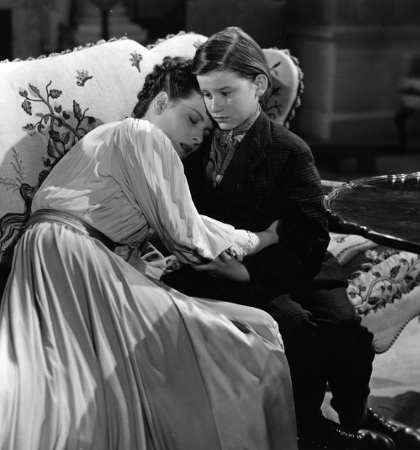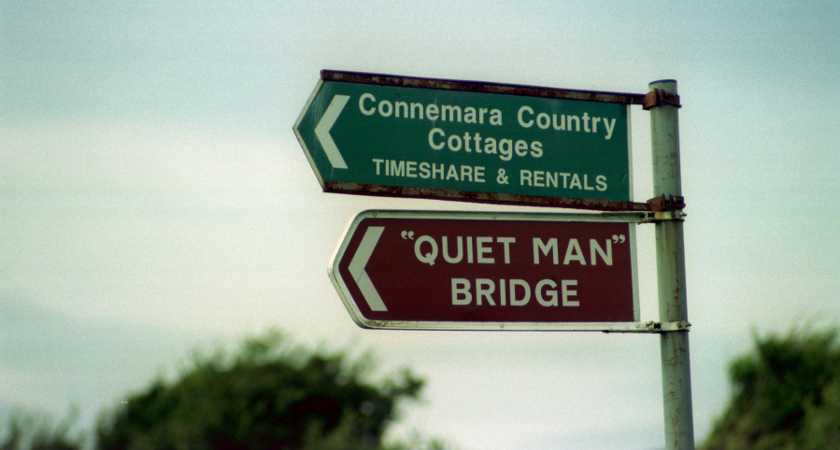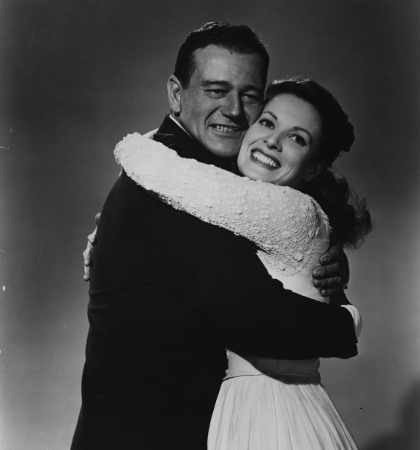KNOWN for her remarkable beauty and her fiery screen persona, Maureen O’Hara, the star of 60 movies, came to Hollywood when she was still a teenager, and almost immediately, she clashed with the men who ran the movie business.
In her own words, “I acted, punched, swashbuckled, and shot my way through an absurdly masculine profession…. As a woman, I’m proud to say that I stood toe-to-toe with the best of them.”
Born Maureen FitzSimons in Co. Dublin in 1920, one of six children, O’Hara began acting at age six with the encouragement of her parents. Her father was a football player, her mother an actress and singer.
At 16 she joined the famed Abbey Players, and was discovered shortly thereafter by the actor Charles Laughton who took her to London and changed her name to O’Hara.
She made her first movie, Jamaica Inn, with legendary director Alfred Hitchcock.
Hitchcock also wanted her to star in Rebecca, but she was filming Hunchback of Notre Dame and director William Dieterle refused to change his filming schedule to accommodate O’Hara.
Soon after O'Hara's arrival in Hollywood she was “sold” to RKO. With little choice over the movies she made, she admits that she made three duds with RKO.
She fought against, but did not always succeed, being cast as the pretty female. “Hollywood would never allow my talent to triumph over my face,” is one of the bon mots she offers.
It was director John Ford who gave her a chance to prove herself a great actress.
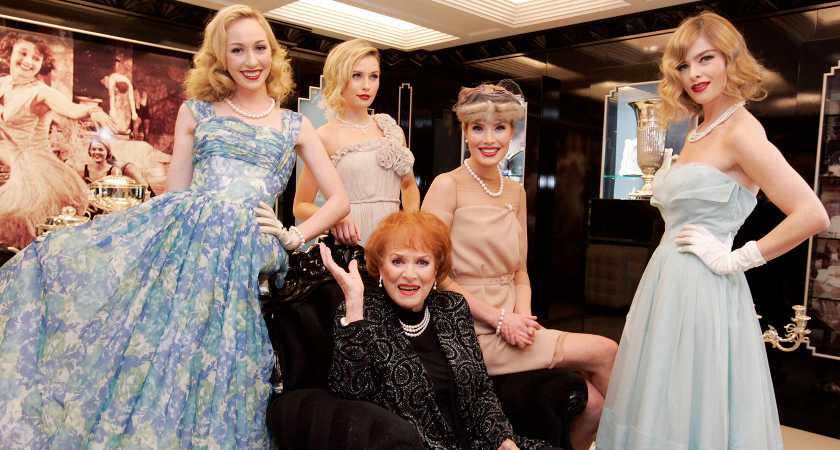 Maureen O'Hara unveiling the Princess Grace Jewellery Collection by Newbridge Silverware in 2010 in Co. Kildare.
Maureen O'Hara unveiling the Princess Grace Jewellery Collection by Newbridge Silverware in 2010 in Co. Kildare.Their first movie together, How Green Was My Valley, won a total of five Academy Awards, including Best Picture.
In all she made five movies with Ford, who used her as his muse for The Quiet Man. She is remarkably frank in her autobiography ‘Tis Herself, about her relationship with the brilliant but troubled director, and with John Wayne, who found in O’Hara not just the ideal leading lady but a pal. In fact, he called her “the greatest guy.”
O’Hara is also frank about her marriages. She reveals that her first, to George Brown, who later became the father of publishing titan Tina Brown, was unconsummated.
And that her second, to Will Price, which produced her daughter Bronwyn, was troubled and deeply destructive.
She eventually found happiness in her third marriage, to aviation pioneer Charlie Blair.
The first pilot to fly a passenger plane non-stop from Ireland to New York, Blair ran a seaplane company in St. Croix. When he died in a suspicious plane crash, O’Hara took over as president of the airline.
She also struck a blow for her countrymen when she took out American citizenship but refused to cite British as her former allegiance because she was a citizen of Ireland.
Her courageous stand soon caused a change in the proceedings, and shortly thereafter natives of Ireland were no longer identified as British in the naturalisation process.
Extremely proud of her Irish heritage, O’Hara served as grand marshal of the 1999 New York City St. Patrick’s Day Parade.
As she walked up Fifth Avenue the crowd called out Mary Kate to her, the name of the character she played in The Quiet Man.
Maureen O'Hara died in the US on October 24, 2015 aged 95.
From shy Dublin girl to the queen of Hollywood, the remarkable life of Maureen O'Hara in her own words...
The Quiet Man...
Everybody in the world loves it because it is a story that could have happened in the countryside of any country. It’s a simple, warm, touching, wonderful story about family and all the squabbles that happen in families. It’s so true to life.
I ruptured a disc on the movie in the dragging scene, but didn’t have the operation until a few years later. I had a great surgeon and he made me wear a brace for six months. I was not permitted to take it off. And I’ve had no problem since. Look at all the stunts I did after surgery. The only stunt I never did was ride – if I got up on a horse I automatically fell off. Not like my sister, who was the first woman to win the Emperor’s Cup in Japan in dressage.
John Wayne...
Such a fine man, he is very hard to sum up in one sentence. He was a decent, fine, wonderful man. He loved his family, adored his kids and was very loyal to his friends. He never let a friend down even if it meant putting himself in danger. There aren't enough words in the English language to describe a person like John Wayne.
Being a woman in Hollywood...
I was accepted as a guy! John Wayne said I was the greatest guy he ever knew. But you were the property of the studio - so you didn’t always have control over what you wanted to do. Anyone under a seven-year contract. We were the property of the studio and they felt that we had to do what they told us to do. And if you refused they had the right to suspend you. And suspending you meant putting you off salary and they put you off salary for the duration of the time it took to replace you, shoot the movie and finish it. So there was a long time when you got no salary and you were not permitted to work for any other company anywhere in the world. That makes it kind of difficult to pay your grocery bill.
Meeting Che Guevara...
It was when we were making Our Man in Havana in Cuba. Che Guevara used to come every evening to the hotel we all stayed in for his go-to-bed cup of coffee or go-to-bed whatever. He would sit and talk to me about Ireland. That was his only conversation – Ireland and the battles. He knew everything about Ireland – every mountain road. And be wore the tam like the rebels used to wear in Ireland. He always wore that tam. Finally one day I said to him, “How does a man from Argentina know all this about Ireland?” He laughed and he said, “My name is really Che Guevara Lynch.” His grandmother, Anna Isabel Lynch, was born in County Galway. He must have learned at his grammy’s or his mother’s knee, because he knew everything about Ireland.
Director John Ford…
You have to realise that he was very abusive to almost every actor who ever worked for him. Every stunt man, every mechanic and every lighting man. He was abusive if it suited him. I used to watch him sometimes and think, “Oh, he is doing that on purpose. He’s after something.” On the set we used to call that “being in the barrel” and every day somebody would be in the barrel. But very few people ever walked out on him. Henry Fonda was one of the few, and that stuntman who became a star, Ben Johnson, walked out on him and wouldn’t work for him again. John Ford was a genius. He was the finest director any of us ever worked with, and we were proud to work with him and work for him. We realised that he was abusive and bad-tempered and awful but we accepted it and forgave him, and we wondered what his problem was really. And I think his problem was that he wasn’t entirely satisfied with his own life. He wanted to be born in Ireland. He wanted to be a military hero in Ireland’s problems. He wanted to be a military hero in the world’s problems.
The real Maureen O’Hara...
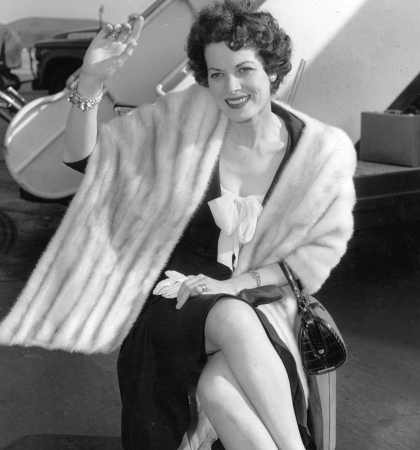 Maureen O'Hara in New York en route to Cuba where she was filming Our Man in Havana. Picture: Getty Images
Maureen O'Hara in New York en route to Cuba where she was filming Our Man in Havana. Picture: Getty ImagesThe publicity people are ordered by the studio to see to it that your name is in the paper every day. So they have to think up a lot of phony stories. One time I read that I’d been bitten by a spider, and it never happened at all. But they had to do that. It had to be something that got printed in the paper, so that your name was kept before the public.
Money...
But then, money had a different value in that time. But it still was terrible. When I made Hunchback of Notre Dame I was paid a British salary because I was under contract to Laughton. He loaned me to RKO Studios and I received $88 a week.
The first time I ever worked in Ireland I made a pound a week and I was typing tags for bags of wet laundry, and the first time I worked on radio for Radio Éireann, I made a pound a week.
Her Irish family...
I worked in connection with theater since I was six. Our mother was an operatic contralto. My sister Peg was a wonderful soprano. My sister Florrie worked in theater and made movies. My sister Margo’s first love was horses – jumping, competing and dressage. And my brother Charlie studied law and was also in the Abbey Theatre and produced many plays in London, and Jimmy, my younger brother, the baby, was also in theater. So we were a theatrical family. I used to do my homework at the back of the stage at The Gaiety Theatre on the top of Grafton Street when mummy was singing.
How Green Was My Valley...
That is one of the classic pictures of the world. And a wonderful story is that when it played in Wales, the Welsh choir got on the boat to Holybead and went to our house in Dublin and serenaded my family. I’d love to have been there but I wasn’t.
The love of her life, husband Charlie Blair...
He flew the first land plane with passengers and mail non-stop from the United States to Shannon. And the plane he went over the pole with is in the Smithsonian, and another of his planes is in a New England museum. He flew the last seaplane out of Foynes and closed that airport. He dipped his wings to say goodbye to Foynes, arrived in New York, got a couple of hours sleep and flew the first land plane into Sharman. He was adored in Foynes. I’ve had people come up to me and say, “My dad was the boatman who used to take all the passengers out to the seaplanes.”
Today’s pretty girls...
I think the problem today is that they are being asked to take their clothes off, and they’ve got to have the courage to say no and believe in themselves.
Article courtesy of Patricia Harty, Irish America’s co-founder and Editor, who inducted Maureen O’Hara into the Irish America Hall of Fame in New Ross in 2011.

